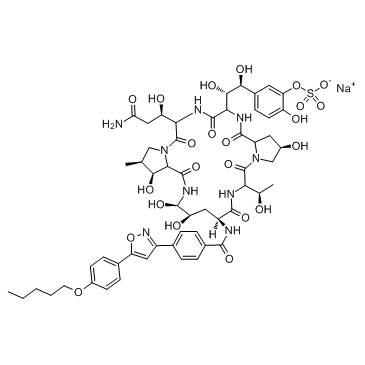| Description |
Micafungin sodium (FK 463) is an antifungal agent which inhibits 1, 3-beta-D-glucan synthesis.
|
| Related Catalog |
|
| In Vitro |
Micafungin (10 mg/mL) phenotypicly decreases the formation of biofilm in most of the isolates. For all the genes tested, the levels of mRNA transcription are also decreased significantly in micafungin-treated samples cf. their untreated counterparts[1]. The combination of micafungin and KB425796-C is fungicidal and markedly reduces the number of CFU, in contrast to the fungistatic effects (no reduction in CFU) observed at all examined time points when each drug is used alone[2].
|
| In Vivo |
Micafungin (1 mg/kg) significantly prolongs survival compared with mice administered saline. Animals given a combination of micafungin (0.1 mg/kg) and KB425796-C (32 mg/kg) show a trend towards prolonged survival in comparison with those treated with micafungin (0.1 mg/kg) alone. In the livers of micafungin-treated mice, the number of CFUs decreases, although the clearance effect is less than that found in the kidneys. Combination treatment with micafungin and KB425796-C results in a significant decrease in the number of CFUs compared with the treatment with micafungin alone at all examined doses. The clearance effect associated with KB425796-C in combination with micafungin is greater than that observed in AMPH-treated animals[2].
|
| Cell Assay |
Each fungal isolate is incubated statically in yeast-maltose (YM) agar broth for 24 h at 30°C. Cryptococcus neoformans YC203 is grown in YM broth medium for 20 h at 30°C with shaking at 200 r.p.m. A cell suspension is prepared by washing the cultured cells once with sterile saline. A. fumigatus FP1305 is cultured on a potato dextrose agar (PDA) slant for 4 days, and spores are then harvested in sterile saline and collected by filtering through gauze. Antifungal activity against all isolates, with the exception of C. neoformans, is measured by the micro-broth dilution method in 96-well culture plates using RPMI 1640 medium supplemented with l-glutamine, but without sodium bicarbonate, and buffered to pH 7.0 with 0.165 m MOPS. ForC. neoformans, yeast nitrogen base-glucose (YNBD) medium is used. For the assay, the test microorganism is inoculated into each well to yield 1×105 CFU/well, and the plates are then incubated for 20 h or 48 h at 37°C. Two end points are determined by microscopic observation: MEC, which is defined as a substantial reduction in fungal growth, and MIC, which is defined as a complete inhibition of growth.
|
| Animal Admin |
Eight groups of ten female DBA/2 mice (7 weeks old) are intravenously injected with 2.0×106 A. fumigatus FP1305 spores. The test groups receive the following treatments: AMPH at 1 mg/kg of body weight/dose given intraperitoneally (i.p.) once daily (q.d.); micafungin at 0.1, 0.32 or 1 mg/kg of body weight/dose given subcutaneously (s.c.) (q.d.); micafungin given s.c. (0.1, 0.32 or 1 mg/kgq.d.) plus KB425796-C given i.p. (32 mg/kg) twice daily (b.i.d.); and saline (b.i.d.). Drugs are administered on days 1 and 2. Five mice in each group are killed 1 day after the completion of treatment. The livers and kidneys are aseptically removed, and each organ is then homogenized in 5 mL sterile saline. Serial 10-fold dilutions of the homogenates are plated on PDA and incubated for 48 h at 37°C, and the numbers of CFU per gram of tissue are then calculated. The survival rate of remaining five mice of each group are examined daily for 31 days after the challenge.
|
| References |
[1]. Bazzi W, et al. The inhibitory effect of micafungin on biofilm formation by Pseudomonas aeruginosa. Biofouling. 2013 Jul 23. [2]. Kai H, et al. Synergistic antifungal activity of KB425796-C in combination with micafungin against Aspergillus fumigat us and its efficacy in murine infection models. J Antibiot (Tokyo). 2013 Jun 12.
|
